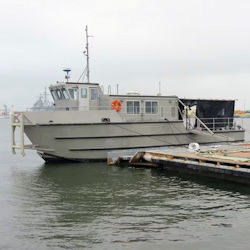30.B Diving Operations.
30.B.01 Staging areas, where the fully suited and equipped diver enters the water, must be selected and configured based on a hazard analysis that includes an examination of:
- Ease of diver access to the water;
- Hazards to diver (currents, equipment, etc.) in route from surface to work area;
- Ability of standby diver to access the water immediately and to reach the diver quickly;
- If used as the topside dive team station, the ability to protect topside members and the standby diver from weather, operational, and other hazards;
- Whether topside equipment can be stowed safely and function properly;
- If diver entry to water is remote from the staging area, the standby diver must be placed at the water entry or immediately accessible to it.
30.B.02 All Dive teams must be manned in accordance with the criteria established in Appendix G.
Diver Rescue Provisions
30.B.03 A standby diver will be provided whenever a diver(s) is in the water to serve as immediate emergency assistance to the primary diver(s).
- Untethered SCUBA divers, working in "buddy" pairs, must have one tethered standby diver at the surface for each pair.
- A standby diver will deploy only after the dive supervisor assesses the situation and instructs him/her to do so.
- The standby diver must be fully equipped to dive and immediately available the entire time the diver is in the water.
- (1) The standby must don all specific gear (suits, harnesses, and equipment) they will wear/use and test all for proper operation before the primary diver leaves the surface.
- (2) With the exception of Appendix G, Table G-3, the stand-by diver must not assume other work responsibilities, other than communications, as required, with the diver.
- (3) All gear must be maintained operational and ready for immediate use for the duration of the dive. If any of the tested gear is exchanged or replaced during the dive, it must be donned and tested by the standby.
- The standby diver must be dressed appropriately for the water and air temperature and remain fully suited up with helmet/mask ready for immediate donning from the time the primary diver leaves the surface until reaching the work area/working depth. The standby may remove the portions of his or her gear needed to prevent heat/cold stress and prevent fatigue. If the AHA identifies a need for the standby diver to remain fully dressed to deploy, it will address measures that will be taken to control these hazards (i.e., standby in water at surface). Any gear that has been removed must be maintained ready for immediate donning and use, accessible to the standby at the entry to the water.
- If configuration of the surface staging area prevents safe, immediate entry of the standby into the water, the standby diver will be placed in the water fully dressed prior to the primary diver leaving the surface, and remain at the surface ready for deployment if needed.
Knowledge Check Choose the best answer for the question.
30-10. What is the basis for determining and selecting staging areas for diving operations?
You forgot to answer the question!

